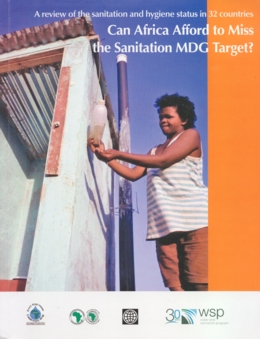 This report documents both the progress and barriers facing countries in their quest to achieve their sanitation MDG. Its purpose is to present an honest overview of the sanitation situation in the region based on 32 country assessments. The report identifies common challenges and issues across countries and discusses some possible solutions and options based on the innovations which are already taking place within the continent and elsewhere in the world. The lessons learned are important for replication and to help achieve scale and impact; these last two being crucial for MDG achievement in Africa.
This report likely to be a valuable resource for anyone working in the sanitation sector. It provides up-to-date comparative data for the region as well as information on strategic areas such as the national policies and institutional frameworks for sanitation within each country; financing and resources; capacity and monitoring and evaluation.
But this report has one other important function: to raise awareness of the state of sanitation within countries, and at regional and global levels. International and national pressure is needed to succeed; this document provides irrefutable evidence: the Africa region requires a mighty effort from all stakeholders to achieve the MDG on sanitation. Table of Contents: Foreword Introduction Executive Summary An Overall Worrying Situation What are we talking about
Sanitation has many dimensions
Sanitation is a complex chain of actors and operations
Sanitation is a business
The overwhelming weight of on-site sanitation in Africa The importance of external factors
Considerable demographic growth
Rapid urbanization
Poverty
Lack of political commitment
Poor coordination
Low level of education
Lack of attractiveness of the sector Africa is not ‘one’ sanitation situation
Fragmented institutions
Policies and strategies – only paper tigers
Local authorities and the limits of decentralization
Access: do we have a clear picture of the situation
Access: the global picture in Africa
Low Access
Slow or no progress
Huge disparities
How many countries are on track to reach the sanitation MDG
Hygiene and behavior change – the poor cousin
Financing
What is to be financed
Financing on-site sanitation
How much will it cost
Policy shift is even more important than ODA money
Looking for sanitation professionals – the capacity issue
Private sector involvement
Monitoring and evaluation Challenges and Encouraging Perspectives
10 Challenges to meet the sanitation MDG target
Challenge 1: Push sanitation higher up the political agenda
Challenge 2: Develop sound policies and strategies
Challenge 3: Prepare sustainable action and investment plans
Challenge 4: Put local authorities in the driving seat
Challenge 5: Build sector capacity with a focus on local players
Challenge 6: Integrate hygiene and sanitation behavior change
Challenge 7: Develop sustainable financing strategies
Challenge 8: Initiate partnerships with the private sector
Challenge 9: Encourage innovation, cooperation and R&D
Challenge 10: Monitor progress and evaluate impact
Encouraging perspectives – what can inspire us
Raising political concern
Sound policies and strategies
New institutional set-ups
Innovative approaches
New financing tools How to Push Forward the S&H Sector
A flexible tool, adapted to a large range of situations
Priority area 1: Institutional Arrangements
Priority area 2: Coordination
Priority area 3: Policy/ Strategy
Priority area 4: Financing
Priority area 5: Demand-led and Supply-fed Sanitation and Hygiene
Priority area 6: Capacity Building
Priority area 7: Devolution of Functions/ Decentralisation
Priority area 8: Measurement of Impact, Monitoring and Evaluation Selected bibliography Methodological note on the cost estimate
Post Date : 01 April 2009
| 